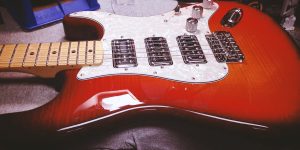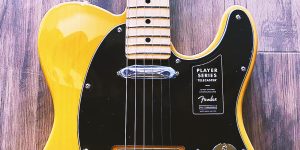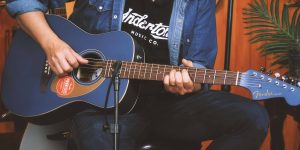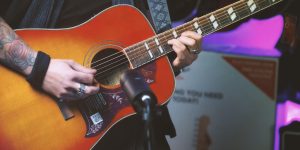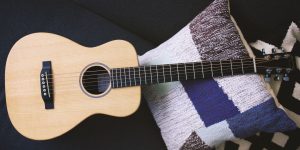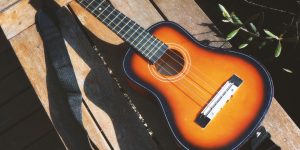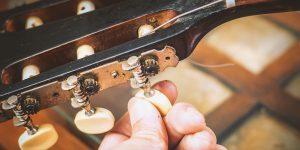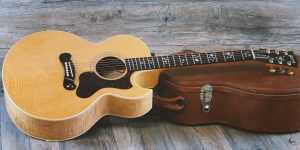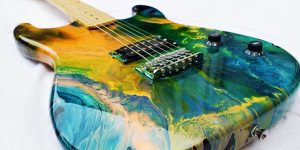In the old days, electric guitars were made from just a few traditional woods: rosewood, maple, mahogany, ash, or alder. Nowadays, these breeds are gradually becoming rarer and rarer and, accordingly, rising in price.
Therefore, most manufacturers have begun to use the production of other breeds that are more common in the region of production but at the same time similar in properties to traditional ones. However, even though new breeds were selected according to the structure and sound characteristics similar to traditional ones, there are still enough differences.
What affects the sound quality of a guitar
The influence of wood species on the tone of a guitar is often underestimated. The sound is transmitted from the string to the pickups. And the pickup indeed picks up the string’s vibrations, but these vibrations are affected by almost every part of the instrument. Different sections resonate differently, thereby amplifying some timbre frequencies and filtering others. In addition, the pickup captures the purely acoustic sound of the guitar, which is added to the primary vibrations.
The influence of the soundboard tree extends to almost the entire sound, but most of all to the phase after the pickup (sustain) and sound decay. The primary phase of the note is more influenced by the type of wood the fretboard is made of unless, of course, the fretboard is not solid. The neck has the most influence on the length of the sustain. The type and quality of the strings, pick, and even the individual characteristics of sound production play a role in the instrument’s timbre.
We must also not forget that each piece of wood is unique in its way – even two pieces of the same species will differ from each other in terms of characteristics. Moreover, each musician has different ideas about good sound.
Types of wood for electric guitars
Agathis
It is a budget “mahogany.” Belongs to the pine family, which grows in many Asian countries. Agatis is cheap, easy to work with, and has pretty consistent results. Used in the manufacture of inexpensive tools. Its timbre can be described as close to mahogany but flatter and not as complex.
Alder

Alder grows in North America. It is a very light wood with a fine-grained structure and even color. According to many luthiers, alder is the best material for electric guitars. Alder has a yellowish-brown color with a pinkish tinge. It is darker than ash, but the ring lines are not as pronounced.
It has a balanced timbre, without exaggeration in any area of the frequency spectrum, except for a slightly more pronounced upper middle. That is why the sound is clear. In addition, alder resonates quite well and has complex characteristics and an excellent dynamic range.
Although alder has become famous for its blues and rock sound, the alder body guitar is versatile and applicable to any style of music.
Ash
Grows in the swamps of the southern United States. In the process of growth, an impressive part of the tree trunk is underwater, resulting from which the wood has a porous structure and is lightweight. Many Fender guitars in the 1950s were made from this breed. Swamp ash is characterized by open pores and hard grain lines between the softer layers. In addition, swamp ash is light, which distinguishes it from hard ash.
The texture of ash is similar to alder grain, yellowish-brown in color, but differs in fatter and darker waves of annual rings. It is a very musical tree, combining brightness and warmth simultaneously with a large dynamic range. Ash has clean, ringing, bell-like highs, slightly sunken but complex mids, and powerful, tight lows.
The midrange characteristics vary quite a lot from piece to piece, resulting in ash guitars sounding more distinct from each other than others. However, they resonate very well across the entire frequency spectrum. Their sound, especially clean or slightly overdriven, is very detailed and complex.
Basswood
Basswood is a very cheap wood. It grows in the Northern Hemisphere. This tree is characterized by lightweight, low density, and softness. As a result, basswood guitars are not as popular as they used to be, although, in the 1970s and 1980s, this was the most common material for budget models. The color of basswood is usually creamy white with a slight purple tinge. The annual rings are barely visible. The texture is very even. Basswood has almost no grain and is very easy to work with.
The sound of basswood is described as “soft,” “muddy,” or “fluffy.” These guitars have a very round, undefined sound without pronounced overtones. The sound is not very detailed and does not have enough “attack.” Due to the low density of the wood, basswood guitars do not sustain well.
Mahogany

Mahogany has an elegant pattern with large pores. The texture is slightly reminiscent of ash but with a more even pattern. Although the color is red-brown, good pieces have a golden sheen covered with a transparent varnish. It performs well in the low-frequency spectrum, a compressed mids with slightly accentuated low mids and soft highs.
The timbre is generally warm, full as if a little nasal. In terms of dynamic qualities, mahogany has a reasonably good sustain. Because of this, solid-piece guitars are well suited for rock music, while semi-acoustic instruments have the warm sound needed in jazz. A separate feature is that age has a positive effect on mahogany. There is an opinion that with each it sounds more interesting.
Maple

There are two types of maple: eastern hard maple and soft western maple. The maple is white, with tight pores and fine lines. Soft maple often has an expressive pattern. Maple is famous for its ability to add brightness to the instrument’s sound. It also helps ensure that each note in the chords sounds distinct and not smeared.
The variety of hard maple is very tough and heavy. Because of these qualities, it is most often used to manufacture necks. Solid maple has a fairly bright sound, with tight, expressive highs and upper mids. Although the bottom end of this breed is not as strong, it is pretty clear, and with the proper pickup with the right amp settings, maple neck guitars can sound great. Another important feature of hard maple is the long sustain. It is an excellent quality, necessary in almost any style of music.
Soft maple is usually much lighter than hard maple but has the same color and is easy to confuse in appearance. It gives the instrument a bright sound but still not as much of a bell as hard maple or other hardwoods. Nevertheless, this breed gives the sound melodiousness at the top and density in the low-frequency spectrum.
Cedar
Cedar is a reddish-brown wood with a rather open grain. This breed is often used to manufacture guitars because it has exciting sound properties. Cedar gives the instrument a very warm sound with well-pronounced overtones. In addition, the midrange is somewhat recessed, which gives the guitar an “airy” quality.
Cedar is a very “soft” wood. It is easy to scratch and damage. Therefore, cedar-topped guitars require more careful use and are not suitable for aggressive styles of music.
Conclusion
As you can see, each type of wood has its own unique set of properties that make it suitable for certain styles of music. Hardwoods like maple and mahogany are better suited for rock and metal, while softer woods like basswood and cedar are better for jazz and blues.
Ultimately, the best way to figure out which type of wood is right for you is to experiment with different guitars and see which sounds best to your ears.
We are supported by our audience. When you purchase through links on our site, we may earn an affiliate commission at no extra cost to you.
Our newsletter
* We will never send you spam or share your email with third parties

